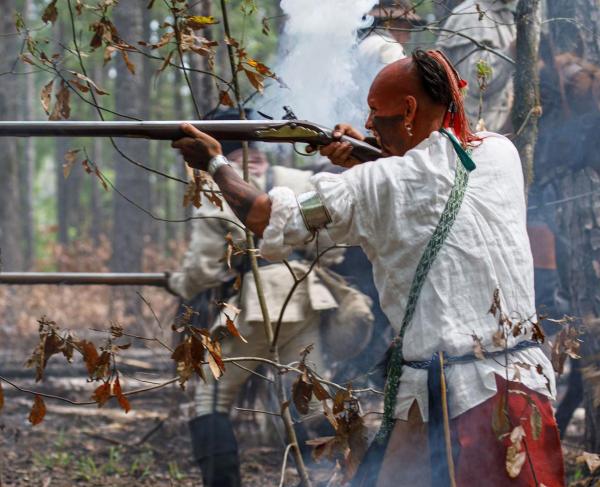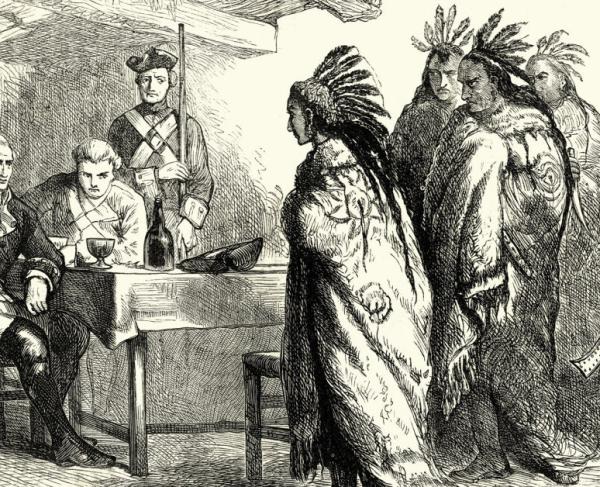Recognize the Contributions of America's Native Peoples this November, Both Online and In-Person
Colleen Cheslak, (202) 367-1861 x7234
(Washington, D.C.) — From the Revolutionary War to the Civil War and beyond, America’s Native peoples have played a pivotal role in our nation’s complex history. For over 200 years, Native Americans have served with distinction in every major American conflict. Each November, we celebrate Native American Heritage Month to honor the culture, history and contributions of Native Americans. The American Battlefield Trust is dedicated to connections, from Sand Creek to Chattanooga.
In recognition of Native American Heritage Month, the Trust recommends the following programs and historic sites to further one's learning.
November 4: “The Art of Looking - Jaune Quick-to-See Smith, Adios Map”, Virtual
The National Gallery of Art is hosting an interactive discussion on Native American artist Juane Quick-to-See Smith’s famous “Adios Map”. The work, created in 2021, features elements from her earlier paintings and reflections on the history of American Indians. Curators from the museum will engage with participants in discussions intended to highlight media literacy and the role of Native American culture in that of the country today. Registration is required to attend. Learn more.

November 11: Veterans’ Day Tribute hosted by the Heard Museum, Phoenix, Ariz.
Celebrating its 10th annual celebration of the American Indian Veteran National Memorial, the Heard Museum is hosting a Veteran’s Day tribute. The tribute will include guest speakers, a reception, music, a Veteran art market and the reveal of the museum’s newest exhibit, In the Service of: American Indian Artists and Tributes. Veterans, plus one guest, receive free museum admission all week from November 8-13. Learn more.
November 11- 13: “National Native Americans Veterans Memorial” at the National Museum of the American Indian, Washington, D.C.
On Veterans Day, the Museum of the American Indian will be performing a procession in honor of Native American veterans and their legacy of service. The procession will be followed by a weekend of celebration with film screenings, cultural performances, activities, and lectures. Learn more.
November 12: “The Story of the 1st Michigan Sharpshooters” at the Museum of Native American History, Bentonville, Ark.
The Museum of Native American History will be hosting a one-hour program on the wartime services of the 1st Michigan Sharpshooters, Company K, during the Civil War. Out of Company K’s 146 men, 139 were Anishnaabek Native peoples of the Great Lakes — the largest all-Native regiment in the Union army east of the Mississippi River. Learn more.
November 12 & 27: "Peace Medals and Promises" Pop-Up Program, Philadelphia, Pa.
Join Independence National Historical Park to learn about the role Peace Medals played in the relationship between the United States and Native nations during the early presidents. Design your own Peace Medals and show how you symbolize friendship and allegiance. All ages and abilities are welcome. Learn more.
November 12-13: The Native American Veterans’ Association 20th Annual Veterans Appreciation and Heritage Pow Wow, South Gate, Calif.
The Native American Veterans’ Association will be hosting their 20th Annual Veterans Appreciation and Heritage Pow Wow. The event will be open to the public and will feature indigenous dancers and drum players. Other programs will include raffles, storytelling, a cake walk, food vendors, craft vendors and other programs that are oriented towards honoring veterans. Learn more.
November 14-20: “Rock Your Mocs” at National Parks, Social Media Campaign
The National Park Service encourages Native peoples across the country to visit their local parks in traditional footwear to express solidarity and embrace their identities. By posting #RockYourMocs photos on social media, they will help raise awareness about the role that Native Americans played on these federally protected lands. Learn more.
November 19: “Difficult Decisions: Native Americans and the American Revolution”, Philadelphia, Pa.
Join Independence National Historical Park as they discuss the role of Native Americans during the American Revolutionary War. This interactive program, led by park rangers, will explore the difficult choices made by Natives to fight or steer clear of the conflict. Learn more.
November 25: Native Voices with Storyteller Dovie Thomason, Washington, D.C.
Come to the Library of Congress to hear storyteller Dovie Thomason share traditional stories about animals and heroes/tricksters that provide a clearer understanding of the values and cultures of the diverse First Nations of North America. Thomason will draw on her own Lakota/Kiowa Apache tradition and experience working with culture-bearers of other Native nations. Both a morning and afternoon session will be offered. Learn more.
November 25: Native American Heritage Program with Joseph Secody, New York, N.Y.
Visit New York’s National Museum of the American Indian and learn about the meaning and history of hoop dancing in Native culture and enjoy demonstrations by top-ranking hoop dancer Joseph Secody (Navajo), who has performed at the Dubai World Expo and World Champion Hoop Dance Contest in Phoenix. Learn more.
Ongoing: “Why We Serve” at National Museum of the American Indian, Online Exhibit
Hop online to experience Why We Serve, an exhibit that honors and recognizes generations of Native Americans who have served in the United States Armed Forces. Audiences can also discover the origins of Native American military service and the stories of those that served in both the Union and Confederate armies during the Civil War. Learn more.

If unable to partake in any of these suggestions, consider visiting battlefields and sites with important Native American ties. Arkansas’s Pea Ridge Battlefield (Pea Ridge National Military Park) hosted the first sizable battle of the Civil War to involve Native troops. Meanwhile, the Cabin Creek Battlefield in Oklahoma was the site of two battles in which Confederate forces were led by Stand Watie — the only Native American to earn the rank of general in the Civil War. The Sand Creek Massacre National Historic Site preserves and protects the cultural landscape of the November 1864 massacre — where 675 Colorado soldiers attacked an encampment of approximately 750 Arapaho and Cheyenne people — and enhances public understanding of the tragic event.
For more travel ideas, check the National Park Service events calendar, visit a state park website, search for museums and historic sites near you, or utilize the American Battlefield Trust’s events calendar and tour recommendations tool. For additional resources on the history of Native American involvement in America’s formative conflicts, you might consider visiting www.battlefields.org/here-from-the-start.
The American Battlefield Trust is dedicated to preserving America’s hallowed battlegrounds and educating the public about what happened there and why it matters today. The nonprofit, nonpartisan organization has protected more than 55,000 acres associated with the Revolutionary War, War of 1812, and Civil War. Learn more at www.battlefields.org.
###

